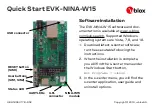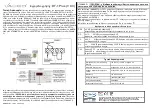
P/N 133487
95
Banner Engineering Corp.
•
Minneapolis, U .S .A .
www .bannerengineering .com • Tel: 763 .544 .3164
SC22-3 Safety Controller
Instruction Manual
Appendix A
A.11.1 Mute Device Requirements
The beginning and end of a mute cycle must be triggered by
outputs from either pair of muting devices, depending on the
application . The mute device pairs both must have normally open
contacts, or have PNP outputs, both of which fulfill the Muting
Device Requirements, described below . These contacts must
close (conduct) when the switch is actuated to initiate the mute,
and must open (non-conducting) when the switch is not actuated
and in a power-OFF condition .
The Controller monitors the mute devices to verify that their
outputs turn ON within 3 seconds of each other . If the inputs do
not meet this simultaneity requirement, a mute condition can not
occur .
Several types and combinations of mute devices can be used,
including, but not limited to: limit switches, photoelectric sensors,
positive-driven safety switches, inductive proximity sensors, and
“whisker” switches . (See Muting Device Requirements, below)
General Mute Device Requirements
The muting devices (typically sensors or switches) must, at a
minimum, comply with the following requirements:
1 . There must be a minimum of two independent hard-wired
muting devices .
2 . The muting devices must either both have normally open
contacts, PNP outputs (both of which must fulfill the input
requirements listed in the Specifications), or complementary
switching action . At least one of these contacts must close
when the switch is actuated, and must open (or not conduct)
when the switch is not actuated or in a power OFF condition .
3 . The activation of the inputs to the muting function must be
from separate sources . These sources must be mounted
separately in order to prevent an unsafe muting condition
resulting from misadjustment, misalignment, or a single
common mode failure . (For example, physical damage to
the mounting surface could cause both muting devices to
be knocked out of alignment, resulting in false muting input
signals .) Only one of these sources may pass through, or be
affected by, a programmable logic controller or similar device .
4 . The muting devices must be installed so that they can not be
easily defeated or bypassed .
5 . The muting devices must be mounted so that their physical
position and alignment can not be easily changed .
6 . It must not be possible for environmental conditions to initiate
a mute condition (e .g ., extreme airborne contamination) .
7 . The muting devices must not be set to use any delay or other
timing functions (unless such functions are accomplished so
that no single component failure prevents the removal of the
hazard, subsequent machine cycles are prevented until the
failure is corrected, and no hazard is created by extending the
muted period) .
A.11 Mute Sensor Pair
The Muting Function
The user is required by OSHA and ANSI to arrange,
install, and operate the safety system so as to protect personnel
and minimize the possibility of defeating the safeguard .
To mute the primary safeguard appropriately, the design of a
muting system must:
1 . Identify the non-hazardous portion of the machine cycle,
2 . Involve the selection of the proper muting devices, and
3 . Include proper mounting and installation of those devices .
The Controller can monitor and respond to redundant signals
that initiate the mute . The mute then suspends the safeguarding
function by ignoring the state of the Input Device that the
muting function has been assigned to; e .g ., this allows an object
or person to pass through the defined area of a safety light
screen without generating a stop command . (This should not be
confused with blanking, which disables one or more beams in a
safety light screen, resulting in larger resolution .)
The mute may be triggered by a variety of external devices . This
feature provides a variety of options (see the following sections)
to tailor the System to the requirements of a specific application .
A pair of muting devices must be triggered simultaneously (within
3 seconds of one another) . This reduces the chance of common
mode failures or defeat .
WARNING . . .
Muting Limitations
Muting is allowed only during the non-hazardous
portion of the machine cycle.
A muting application must be designed so that no single
component failure can prevent the stop command or allow
subsequent machine cycles until the failure is corrected (per
OSHA 1910 .217(c)(3)(iii)(d), and ANSI B11 .19) .
WARNING . . .
Mute Inputs Must Be
Redundant
It is not acceptable to use a single switch, device,
or relay with two N.O. contacts for the mute inputs. This
single device, with multiple outputs, may fail so that the System is
muted at an inappropriate time .
This may result in a hazardous
situation.
















































